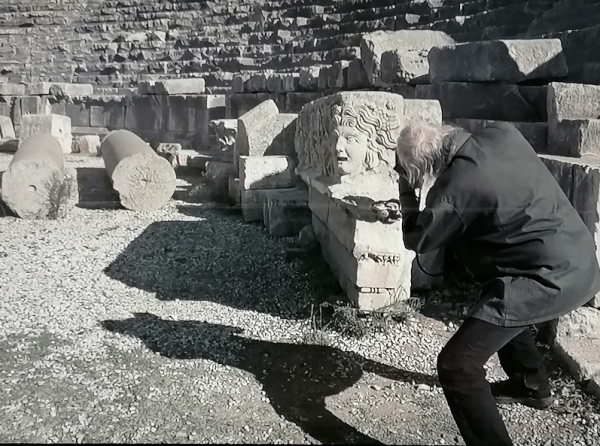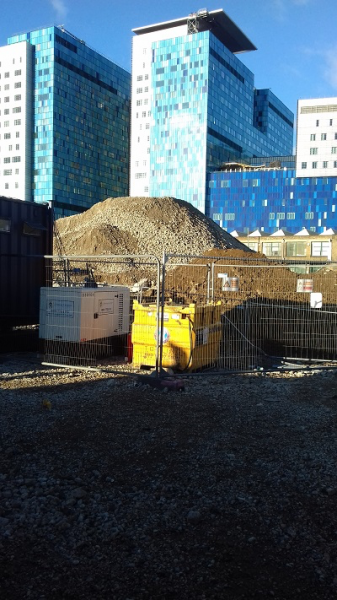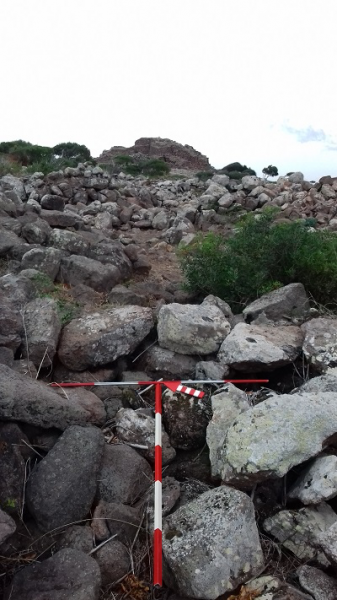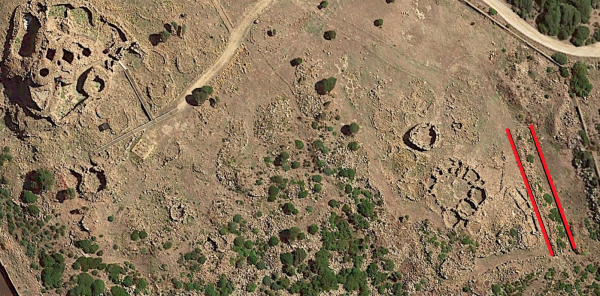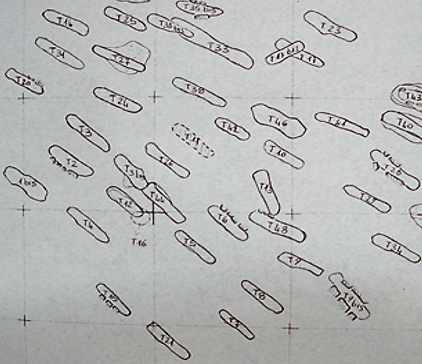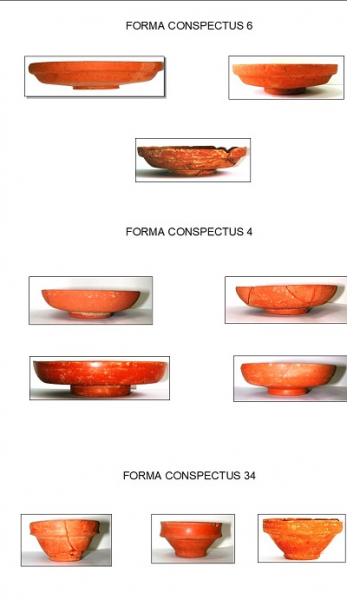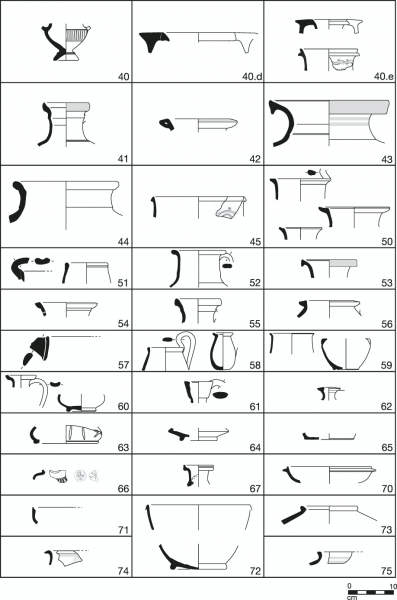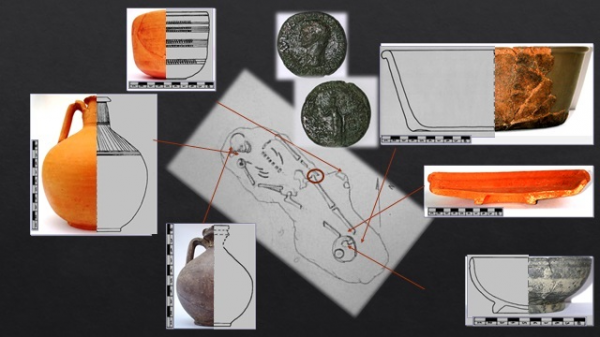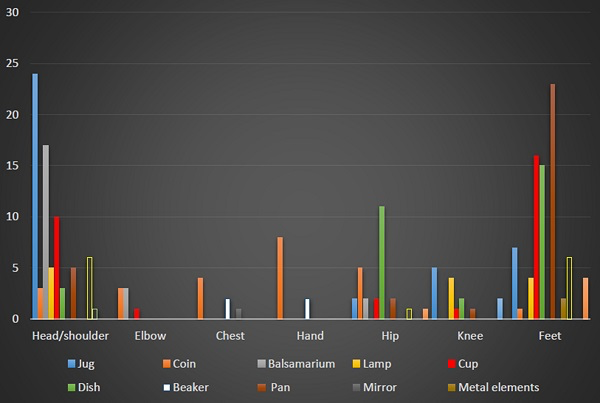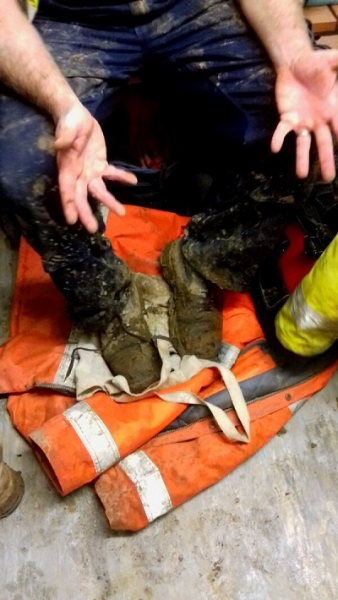Why archaeology today? What archaeology today?
Material traces and absences of the past as cultural signs of the present Pourquoi l'archéologie aujourd'hui ? Quelle archéologie aujourd'hui ? Traces et absences matérielles du passé comme signes culturels du présent
Mauro Puddu
Marie Skłodowska-Curie Fellow
University Ca’ Foscari of Venice, IT
This paper questions archaeology as a practice that, by unearthing and interpreting the signs of the past, leaves its own traces on the present of a site, a district, a community. Archaeology can be used to do so by different stakeholders, through the creation of discontinuity both in a region’s landscape – i.e. by choosing to attract visitors towards an archaeological site/museum rather than towards others – and in the history of a community – by implicitly (but also explicitly) giving the status of historical apex of a civilization to a specific period/event/monument according to which every other age is adjusted. This creates an unbalanced picture made of centres and peripheries. The few key archaeological ‘centres’ spread around the world and the uncountable neglected ‘peripheries’ that derive from this practice have an impact on our understanding of humanity. Bearing in mind this inevitable capacity of archaeology to leave material and cultural traces on us, this paper asks if and how archaeology can be used to have a positive impact on present societies answering current social questions. Does such practice just generate an indiscriminate accumulation of objects that will never be either studied by specialists or exhibited to the public tending to make museums’ storages collapse? Or does it help local and global communities to reflect upon themselves bearing an historically deeper viewpoint on humanity? Is archaeology used to justify actions taken in the present, to look for signs of prestigious ancestry, or as a medium towards accepting and dignifying otherness? Answers to such questions vary sensibly depending on the semiotic stand that specific archaeologists, as actors within the discipline, take on archaeology as a practice, whether they see it, in synthesis, as a discipline of things or as a discipline of traces. Reflecting on a few case studies such as Koudelka’s “Walking Through Outdoors Ruins” project for Magnum, the archaeology or Bronze Age Sardinia, and the dominant paradigm of communicating archaeology to the public, this paper exposes the social roles that archaeological interpretation has had so far, attempting a prediction of its future paths until some of its possible extreme – Funes el-memorioso driven – consequences.
Cet article interroge l'archéologie comme une pratique qui, en exhumant et en interprétant les traces du passé, laisse ses propres traces dans le présent d'un site, d'un quartier, d'une communauté. L'archéologie peut être utilisée pour cela par différents acteurs, à travers la création d'une discontinuité à la fois dans le paysage d'une région – c'est-à-dire en choisissant d'attirer les visiteurs vers un site/musée archéologique plutôt que vers d'autres – et dans l'histoire d'une communauté – en donnant implicitement (mais aussi explicitement) le statut de sommet historique d'une civilisation à une période/événement/monument spécifique à,partir duquel tout autre âge est ajusté. Cela crée une image déséquilibrée faite de centres et de périphéries. Les quelques « centres » archéologiques clés répartis dans le monde et les innombrables « périphéries » négligées qui découlent de cette pratique ont un impact sur notre compréhension de l'humanité. Compte tenu de cette capacité inévitable de l'archéologie à nous laisser des traces matérielles et culturelles, cet article se demande si et comment l'archéologie peut être utilisée pour avoir un impact positif sur les sociétés actuelles en répondant aux demandes sociales du temps présent. Une telle pratique ne fait-elle que générer une accumulation indiscriminée d'objets qui ne seront jamais ni étudiés par des spécialistes ni exposés au public tendant à faire s'effondrer les réserves des musées ? Ou aide-t-elle les communautés locales et mondiales à raisonner sur elles-mêmes en portant un point de vue historiquement plus profond sur l'humanité ? Est-ce l'archéologie utilisée pour justifier des actions menées dans le présent, pour rechercher des signes d'ascendance prestigieuse ou comme un moyen d'accepter et de dignifier l'altérité ? Les réponses à telles questions varient sensiblement selon la position sémiotique que les acteurs de la discipline adoptent sur l'archéologie comme pratique : si les archéologues la voient, en synthèse, comme une discipline des choses ou comme une discipline des traces. En réfléchissant à quelques exemples d’études telles que le projet « Walking Through Outdoors Ruins » de Koudelka pour Magnum, l'archéologie de l'âge du bronze et de l’Âge romain, et le paradigme dominant de la communication de l'archéologie au public, cet article expose les rôles sociaux que l'interprétation du passé a joués jusqu'à présent, tentant de prédire ses trajectoires futures jusqu'à certaines de ses conséquences extrêmes – comme en Funes el-memorioso de Borges – possibles, en essayant de comprendre comment les éviter.
Index
Mots-clés : archéologie, archéologue, corps, objet dynamique, ruines
Keywords : archaeologist, archaeology, body, dynamic object, ruins
Archaeology: a word and its popularity
Today’s World is pervaded by archaeology. At least it is so by the world archaeology. What does such pervasiveness mean for the world we live in? Whether the popularity of the word coincides with that of archaeology as a practice/discipline is debatable. Nevertheless, the ubiquitous presence of archaeology in television, newspapers, and (also non-archaeological) museums is an important sign of our times, sufficient to claim attention from professionals of both archaeology and semiotics, as Archeosemiotique dossier project invites us to do.
Few examples of archaeology’s popularity are provided by two art exhibitions on in Rome during summer/autumn 2021: first, the Magnum exhibition held at the Ara Pacis Museum on the photographic work of archaeological undertaken between 1991 and 2015 by photographer Joseph Koudelka; second, the display, at Galleria Borghese, of 80 works by artist Damian Hirst’s “Treasures from the Wreck of the Unbelievable” series, displayed along the museum’s ancient masterpieces. The latter, with the title Archaeology Now, aims at providing ground for interaction between the modernity of Hirst’s dynamic creations and classical sculptures, Italian paintings of the Renaissance and the 17th century, and the works of Bernini and Canova. The former exhibition, with the Italian title “Radici” (roots) – but with original title “Ruins” – aims at putting together Koudelka’s endless research for beauty and fine light and the continuous, surprising discovery of change in the remains of the ancient world (Figure 1).
Figure 1. Magnum Photographer Joseph Koudelka caught in the act of shooting a column in the shape of a Medusa’s head, in an ancient amphitheatre in Turkey (Photo Credit: “Ruins” Exhibition, Magnum Agency 2020)
Both exhibitions frame the remains of the past as dynamic entities: Hirst’s works, dialoguing with the Galleria Borghese’s works of art, bring new vigour to antiquity providing it with a contemporary eye (Figure 2); dynamism and change are also the engines of Koudelka’s work. Despite capturing elements generally seen as lifeless and passive, such as the collapsed vestiges of classical civilizations, by seizing them under diverse lights at different times of the day across 25 years, Koudelka’s shots document the vitality of the ancient matter. This is retrieved by the different ways it is hit by sunlight, authenticating the aging of ruins, their fading visibility, their caducity, and ultimately their liveliness.
Figure 2. Statue of a woman created by artist Damien Hirst as a sculpture allegedly recovered after 2000 years from a shipwreck, exhibited together with other works of classical art at the Galleria Borghese, Rome (Photo Credit: Personal Archive 2021).
The arts-filtered images of archaeology that we gather from Hirst and Koudelka are those of a discipline that needs to cope with the dynamism of the remains of the past. However, what precise dynamism do we need to deal with? Certainly the slow but inexorable physical changes that occur to the materials from the past; but also the conceptual and societal changes that inevitably influence – and are influenced back by – the knowledge produced by the archaeological scholarship. This idea of a twofold dynamism of the vestiges of the past, both material and conceptual, is quite distant from a generic idea of archaeology dealing with old, immutable objects. In fact, how can archaeology capture change of the matter while taking into account the change of ideas? What tools is archaeology provided with to succeed in this task?
To answer these questions, it is necessary to ask first what archaeology is and what archaeologists do on the field, first of all physically, and then from a theoretical perspective. This paper focuses on the activities of the archaeologists framing them as a question of meaning. What is the meaning of archaeology, as in its purpose? What do the remains of the past mean? What do we see and what do we look for when focusing on them? As Zoe Crossland (2021, 85) puts it, ‘archaeology started off with the wrong foot when it came to questions of meaning’. These questions have been faced several times, particularly during the so-called semiotic-turn of archaeology in the 1980s’ (Gardin, 1992), but they have been archived staying partially unanswered. Dealing with a practice made in its first and unavoidable phase of dust and fatigue, many practitioners of archaeology find that the only knowledge is represented by hard data, especially artefacts that are treated as things directly witnessing a tangible past. This way though, things tend to become the main focus of archaeology. Indeed archaeology has been defined ‘a discipline of things’ (Olsen et al. 2012) as some important archaeology and anthropology books seem to support: The Comfort of Things (Miller, 2008), Tangible Things: Making History through Objects (Gaskell, Schechner, Ulrich, Carter, 2015), Material Agency: Towards a Non-Anthropocentric Approach (Knappet, Malafouris 2008), Materialising Roman History (Van Oyen, Pitts, 2017). Nevertheless, can we be sure that things are the purpose of archaeology? Or is rather the recognition of those objects as traces – signs – of something else, more dynamic, subtler, less immediately graspable, to trigger the archaeological thought? What do we risk accepting a one-on-one correspondence between objects and the past? And what do we lose ignoring that ‘our experience of the archaeological past is always mediated and is therefore an exercise in material semiotics?’ (Crossland 2021, 87).
1. Physical traces of archaeological practices
Archaeological practitioners hold numerous activities on the field while searching for the remains of the past. Excavation is certainly the most iconic of all archaeological actions. The unearthing of vestiges of the past is always an exciting moment, for both those at work and those watching. This operation unveils structures ranging from dwellings to graves, from solid walls to subtle post-holes hinting at wooden buildings, from farming areas to industrial ones. By uncovering these structures from the earth deposited on top through the centuries though, archaeologists hold simultaneously two more practices. The first: destroying – removing systematically following the stratigraphic principle – the layers of deposit covering what was brought to light. Archaeology is a destructive act: this is why it is important to document through photo, drawing of plans and sections, and now through 3D scanning, all layers before being removed. The second: accumulating spoil. Tall and numerous spoil heaps are an integral part of archaeological sites. These simultaneous actions create a landscape that should be familiar not only to the professionals, but also to those observing from the outside. Figure 3 represents a long spoil heap on a site in Dagenham, east London, around the first Ford factory, where Roman period remains were recorded by the north bank of river Thames: the whole area was a large fenced development site while the excavation went on, but the spoil heaps were easily visible to people outside, particularly from double decker buses. Figure 4 represents another spoil heap in a urban setting, by Whitechapel hospital, central London, where modern to iron age archaeology was being unearthed. There, the spoil heaps were certainly visible from the hospital and from the Idea Store Whitechapel Library.
Figure 3. Man walking on the spoil heap created from archaeological and demolition activities in the area of Dagenham east, London, UK (Photo Credit: Personal Archive 2018).
Figure 4. Spoil heap of archaeological activities from a site in Whitechapel, east London, against the background of Whitechapel Hospital (Personal Archive 2018).
These examples show that archaeology affects the aesthetic of urban or rural landscapes temporarily. But it can also do so in the long term. Figure 5 represents a rural landscape in a black and white shot taken at the beginning of the 20th century, whereas Figure 6 portrays the same site in early 2000s’. What strikes between the two photos is the rounded hill-like shape of the mound in Figure 5, and the neat, tower-like shape of the background in Figure 6. The difference in the landscape is given by a series of archaeological excavations (Sabatini, Santoni, 2010) that have liberated one of the several thousands of bronze megalithic complexes, named nuraghe Seruci, Gonnesa, southwest Sardinia, from the vegetation and the heaps of collapsed stones around it.
Figure 5. Nuraghe Seruci, Gonnesa, southwest Sardinia, at the beginning of the 20th century, before the archaeological excavations (Photo Credit: Lord Ashby 1921 from the archive of the Comune di Gonnesa).
Figure 6. Nuraghe Seruci, Gonnesa, southwest Sardinia, after the archaeological excavations and years long conservation (Photo Credit: Personal Archive 2020).
Figure 7 shows a stone heap created, on the right side of the photo near the fence, during phases of liberation of the nuraghe from the collapsed stones in the early 2000s’. The pile, over one metre high and very close to the original iron age structures, was removed in the spring of year 2020, the stones being dispersed along the site’s fence. This means that the result of archaeological spoil was for at least a decade visible to the visitors of the site, testifying the long tempo of archaeological practice.
This is to say that every action undertaken on site by archaeologists has a physical impact on the site. They bring back to light things that had not been visible for a variable span of time, from decades to centuries or even millennia; contemporarily, archaeology creates physical landscapes that, as small and insignificant they might seem, still attest something else. Such landscapes stand for a time-and-energy-consuming work that does not make things appear and disappear suddenly, but that moves around heavy amount of matter that stay on site more or less temporarily. Although this creation of deposits is physically evident on site, there is another type of accumulation that archaeology tends to create: a less visible one, but not for this reason lighter to move from place to place. This is the creation of images of the past that stay in the history of a specific site, in the knowledge of an historical period, in the imaginary of a community, even after their overcoming.
Figure 7. Aereal photo of Nuraghe Seruci with highlighted the pile heap of stones to the right near the site’s fence (Photo Credit: my elaboration of Google Earth 2019).
2. The things/traces archaeology studies
Discussing the aims of archaeology, Lewis Binford stated, quoting Braidwood, that in the 1960s’ ‘most archaeologists would agree that we should not lose sight of “the indian behind the artefact” (Braidwood, 1959, 79) and would accept as a major aim of archaeology the reconstruction of lifeways’ (Binford 2008, 6). We can say that still today, likely, most archaeologists would agree with that thought. As Binford put in a crystalline way, reconstructing the ways of life is the meaning of Lisa Braidwood’s metaphor of the Indian that some archaeological research tended to forget due to too much focus on the artefact. However, the lifeways of a society can be understood very differently depending on the theoretical system of ideas used to frame data. Ian Hodder (1985, 7) criticised that simple but persistent metaphor by arguing, contra Flannery (1967) that ‘the aim is to reach not the Indian behind the artifact, but the system behind both Indian and artifact (Flannery 1967)’. Such processual approach creates the perception of an innate natural system ‘to which the Indian is subordinate and helpless, has the result that the social analyst puts him/herself forward as having specialist knowledge and insight’ (Hodder 1985, 21).
From these considerations follows that if archaeologists are focused on the artefact only, which is on things, they will collect their hard properties as dry facts that can be used to fill in a very detailed database, but that does not automatically help contribute to the history of humankind – of the Indian behind the artefact – until seeing and using those things as traces of something else. Which is, until they give them both a semiotic dignity and an openness that allows data being reinterpreted. Such process can only start by admitting the necessarily semiotic nature of archaeology.
I will now share an example of around a decade long archaeological research – with interruptions – that I have undertaken from different institutions and points of view.
2.1. Objects as material culture or material culture as objects
In 2007, during my Masters Degree in Classical Archaeology at the University of Cagliari, I was being trained on materials coming from the Roman period necropolis of Masullas, central west Sardinia, excavated in the mid 1990s’ by a team of the Soprintendenza Archeologica della Sardegna (local department of antiquity) directed by Donatella Mureddu. As my task was to catalogue those objects, or grave goods, I asked my tutor, Simonetta Angiolillo, professor of Greek and Roman Archaeology, to make it part of my Masters’ dissertation. She directed me towards providing a study of the material culture coming from the 54 graves excavated (Figure 8) that could contribute to the understanding of the phenomenon of Romanization in Sardinia. Intuitively, Romanization indicates the progressive reduction of the cultural distance between Rome’s culture and the cultures of the people with which Rome interacted in a range of ways, from war to trade. However, where Rome and the others meet culturally changes with what one means for Romanization. In most traditional approaches, Romanization explains the acculturation through which people in the provinces adopted cultural practices from Rome. Until recently, Romanization defined a very unidirectional process of acculturation that Rome imposed over indigenous peoples (Soria, 2013: 713), often through coercion and violence (Fabião, 2001: 110); today, archaeologists leave more space for acculturation also as integration and even self-Romanization (i.e. Lo Cascio’s lectures http://scienzeumanistiche.uniroma1.it/guide/vs_moduli_orario_2007_8b.aspID_modulo=272).
Figure 8. Plan of Roman period necropolis Sa Mitza Salida, Masullas, west central Sardinia, drawn by Sannia in 1997 (Photo Credit: Archive of Sopritnendenza Archeologica della Sardegna).
One convenient method to track down the material signs of Romanization is highlighting ‘the adoption of Roman material culture’ in the provinces (Van Dommelen, 2001: 71). That is what I did in 2007, turning my focus on those objects, retrieved during the excavation of the burial ground of Masullas, that were easily recognisable as representatives of Roman material culture: particularly, the presence 3rd-1st centuries BC black gloss vessels, 1st century AD red-painted vases named sigillata italica (Figure 9) – Samian ware – or 2nd 6th century orange-painted vessels known as sigillata Africana would make us lean towards the interpretation of a site as a Romanized one. Such method encouraged me to find connections between Rome and Sardinia. The drawback was that I was tempted to create a direct correspondence between a class of objects and a culture: an approach that goes under the name of culture-history. This is informed by Chillde’s definition of archaeological culture as a complex of ‘certain types of remains – pots, implements, ornaments, burial rites, house forms – constantly recurring together’ that should have been left by ‘what today would be called a ‘people’’ (Childe 1929: v, vi). The hitch of such method is the tendency to attribute a degree of Romanization to each grave/household based on the aesthetics of the material culture found inside; very Romanised, fairly Romanised, and non-Romanised, were the mental boxes in which I implicitly stored those graves (and the people buried in them), ultimately contributing to shape a binary antiquity, formed either by Romanised communities or by communities that were not.
Figure 9. Classification of locally produced pottery in Sigillata Italica from Sa Mitza Salida, Masullas (Photo Credit: Personal Archive 2016).
During the discussion of my dissertation, my tutor made me notice that I focused so much on the material culture as objects in themselves that I neglected the people buried in the necropolis. She was right, I failed to find the Indian behind the object, and the objects, with their formal properties, took the lead. This was my full responsibility, but it also happened because through the years in Cagliari I had become familiar with a specific visual way of representing archaeology: through typologies and series of objects (i.e. this classification of ceramics from Rhodes in Figure 10 from Anna M. Puig 1998), their minor variations, used to locate them spatially and chronologically: place of production, date of production/use were – and still are – the first challenges archaeologists face.
Although I did use those formal qualities to underline that they were sign of something else, for example having in mind the ideas that might have inspired the potter, my level of interpretation there was low because low was the level of signs-interaction that I sought. What I was doing then was singling out – almost – one object to put it in direct relationship with history. Accounting for other elements present in the graves, and signs that could put under crisis a simplistic binary ON/OFF system – Romanized/non-Romanized – was the next step I had to take. This absence of the person from the grave, for which I was invited to continue to study the necropolis, was for me first and foremost, the absence of the body.
Figure 10. Catalogue of ancient pottery shapes from Rhodes (Photo Credit: Puig 1998).
2.2. Objectifying the dead
Those vessels, coins, glass objects, bronze bands, were introduced in the graves of Masullas for two reasons: first, to accompany the departed person; second, to represent the community to which those dead belonged. During the following phase of research, contemporary and subsequent to my MA at UCL, I addressed my former tutor’s question on the absence of people by focusing on the relationship between grave goods and the skeletal remains in the grave. My approach was to find possible distribution patterns of the grave goods both around the grave and the body parts of the deceased (Figure 12). I managed to find a few. As Figure 11 (from Puddu 2018 Figure 4.11) shows for the case of grave 3bis, dated to the 1st century AD, vessels for pouring liquids such as jugs or balsamaria are located by the head of the deceased, whereas open forms such as dishes or cooking pans are located by the feet of the buried individual; the coin is by the hip bones of the deceased. This pattern is, with minor variations, repeated with precision in most graves from the 1st to the whole 3rd century AD included. The repetition of those gestures could be seen as the sign of ‘a widely shared social identity among the members of the community’ expressed through a ‘formidable continuity with the past’ (Puddu 2018, 85).
Figure 11. Elaboration of Grave 3bis distribution of material culture around the body of the deceased, from the necropolis of Sa Mitza Salida, Masullas (Photo Credit: Personal Archive 2020).
Figure 12. Chart of grave goods distribution around the body of the deceased from the roman period necropolis of Sa Mitza Salida, Masullas (Photo Credit: Puddu 2018).
At this stage, this research arrives where I stand now. Whether the community members participating in these funerary collective events were spontaneous in repeating their funerary rituals or were somehow acting through a shared ideology imposed top down is hard to say until other elements are considered. Particularly, to have an interpretive upgrade of the Roman-period community of Masullas, I deem necessary to research their body as a strong actor of the community identity. So far indeed, the bodies of those people were considered as actors only once: when they are described as people taking part in a funeral and making specific gestures to create a grave space in which likely the community recognised itself. Other than that, the moving body is barely touched upon, if not, sometimes, completely absent. This absence needs to be explained, and it is only one of the several that force archaeologists to deal with the that the reconstruction of the past inevitably creates, although sometimes generating proper dominating – if not hegemonic – categories of objects or of topics over other neglected ones.
2.3. Archaeological empties
Some absences, or underrepresented elements in archaeology are often inevitable due to their material nature: wooden tools, clothing, or maybe potential rag objects, are lacking in the archaeological record because the conditions for them to be preserved underground are rarely favourable. Timber and fabric deteriorate easily in most archaeological conditions, as they are very easily affected by lack of humidity, dryness, insects, microorganisms, as much as the flesh and skin. For the same reason, we have a thin archaeological knowledge of the tattooed skins of men and women in antiquity, with rare exceptions coming either from iconographic or literary sources such as Herodotus (Annales, Book 5-6) describing the tattooed communities amongst the Thracians (Zidarov 2017, 137-149), or from perfectly mummified human remains from Egypt (Friedman 2017, 11-37) or South America (Deter-Wolf 2006). Their material qualities allow instead stone tools and pottery to be found very easily, as they do not need specific conditions to survive. This is how most publications are rich of ceramic seriations such as that seen in Figure 9. It is also true, though, that more sophisticated techniques and research questions have recently arose – i.e the study of pollens through palynology – and have been used to overcome pottery’s “tyranny” as a guiding fossil.
Another unbalance internal to archaeology derives from limits of space, time and resources, that do not allow to produce equitable projects. For example, Sardinian landscape is punctuated by numerous megalithic tower buildings built around the mid-end of bronze age, known as nuraghi: an official count of 7000 nuraghi has so far been provided by archaeologists working on the survey of buildings in the island. Nevertheless, not even 1% of them has been excavated so far, and of the excavated ones, only one has been included in the UNESCO lists of the protected heritage sites, because, the UNESCO motivations read, “the archaeological site of Su Nuraxi di Barumini is the pre-eminent and most complete example of the remarkable prehistoric architecture known as nuraghi.” The excavation of one site retrieves certain elements that might be representative of other sites, but some other finds are also unique: hence, considering representative one specific site although thousands of apparently similar ones have not undergone investigation yet, is perhaps a long shot. Being aware of the gaps and peaks that archaeology creates while creating images of the past is essential in helping to form an agenda in which this methodological handicap is addressed.
Another archaeological gap, influenced by the way research questions are framed rather than by material durability, is that between the space given in publication to elites-related finds and non-elites-related ones. Although pottery is the most available material in archaeological contexts, different ceramic classes are given dissimilar relevance. Studying of roman-period burials from the Cagliari’s national archaeological museum, Sirigu (2003) focused on the so called “morte povera”, the burials of the lower classes. What he found in terms of representativeness is significant of how archaeology can be decisive to fill – or enlarge – knowledge gaps: the so-called “ceramica commune” – coarse ware – ‘has endured a process of removal or at least underestimation, due to which both its quantitative and qualitative presence in the archaeological sites have been ignored for a long time’ (my translation of Sirigu 2003: 113). We discover then that under-representation of material culture classes can also derive from its too common availability, if something is considered too common to be significant: over-representativeness paves the path to oblivion. From this find, Sirigu proposes that since coarse wares were the most available ‘to lower social classes (those numerically – but not politically or economically – more relevant) the under-estimation of the informative potential of this class of objects has produced a historical distortion in the analysis of the social and economic mechanisms that characterised life during the roman age’ (my translation of Sirigu 2003: 113).
This attitude can be highlighted within all roman provinces, and it tends to present what Mike MacCarthy’s calls ‘a VIP version of history because they focus on conquest and elites’ (MCarthy 2013:9). Along the same lines of what presented for Sardinia by Sirigu, McCarthy underlines that such biases are enhanced by the ‘by the pathetically small number of cemetery investigations and skeletal remains’ (Ibid). For McCarthy (2013, 10) this generates a silencing of most of actions and communities of the Roman period, especially since many archaeological reports ‘heavily rely on descriptive account of what has been found’, rather than deepening the theoretical framework through which those finds will be put in order. These passages help me to reconnect to the dichotomy things/traces with which this paper started.
3. Retrieving the dynamic body to re-establish Archaeology’s semiotic continuum
The call for papers of the archeosemiotique dossier stated quite proactively that either archaeology is archaeo-semiotic or is nothing. It did so, probably winking at the famous adagio by Willey and Phillips (1958,2) that either ‘American archaeology is anthropology or it is nothing’. We have seen in the previous section that understanding archaeological finds as things to describe does not prevent them from being interpreted; it rather allows them to be used in an apparently objective and innocent while feeding dominant paradigms, as is the VIP version of history. Some of these mechanisms, it might not surprise, are not entirely entrenched in our knowledge of the past; although projected into the past, they are formed in, and express needs of, the present. Seeking for fame and elitism is a thing in today’s world. The quality through which fame – no matter how ephemeral – is socially perceived today is visibility. The tools through which this quality is achieved vary, with mainly social networks at the forefront. In the archaeological picture provided above, visibility is mostly held by elites, through the primary position often given to objects that are assessed as economically and aesthetically valuable.
This way, we are hit by an ancient world where things and buildings almost move by themselves; where rulers and elites write about themselves and are fed by self-cultivating grains. Although mine is certainly a caricature, the overwhelming presence of artefacts in the construction of the past, tends to obscure the subalterns (sensu Gramsci) and the human body, which is the only possession that, often, subalterns had.
The absence of a systematic theorization of the body in archaeology was treated as an issue already in the early and late 2000s’. Meskell (2000) examined the intellectual legacy that social studies of the body held in the previous 20 years had on archaeology, which was still relatively new to making a real contribution to the subject. In 2008, Robb and Boric collected in a volume entitled Past Bodies several essays that are presented as a reaction to decades of the body’s invisibility. These efforts paved the path for a great potential of archaeological studies with the body at the centre. But although the number of titles on the subject has been growing lately, the topic is still far from taking off in its theoretical dimension.
In his collection of essays on the body, Umberto Galimberti (2002) dialogues with several authors, from Plato to Saussure, from Sartre to Marx, from Nietzsche to Derrida, who have dealt explicitly with the theme of the human body. In one of those dialogues, notably with Merleau-Ponty, Galimberti comes to the realization that nowadays the human body is met only in a series of degraded definitions through which, by time, has been objectified (2002: 116). The objectification of the body derives from a very similar process to the objectification of material culture, but it reaches a more spectacular level of evidence: about the extreme consequences of such attitude journalist Alberto Angela (2021) has written recently a long form in the pages of Italian newspaper Repubblica (16.10.2021) dedicated to “la notte dei cristalli” in the Roman ghetto that occurred in the night of 16th of October 1943.
Although today’s world is overwhelmed with images of the human body, this is usually either a body posing for photographs in order to influence the crowd, or an inert body meant to be catalogued as either an organism to cure, as labour-force to employ, or an anatomic object. This is the result of an attitude that has solved the whole world in an object to possess and catalogue, and has downgraded the human body to an object of the world (Galimberti, 2002: 116).
Archaeology too can be critically addressed from this perspective. When the body is seen exclusively in physical anthropology terms we still miss the dynamic body. This happens, for instance, when it finds a small space in the anthropology session of an archaeological monograph, where the two do not always connect properly. As put by ostheo-anthropologist Joanna Sofaer, ‘the post-processualist emphasis on actors and agency required bodies’ (Sofaer 2006, 18), but the divide between anthropology and archaeology does not help to grasp them. But even if this disciplinary divide was to be overcome, another gulf complicates the subject: the systematic application of the Cartesian dualism, mind/matter, to the distinction between dead and living body (Sofaer 2006: 40).
In order to escape the trap – or at least to see it – of the objectification of the body, entrenched in the Cartesian duality between mind and matter, Galimberti suggests to think of human body as a body that pushes, pulls, lifts up the things of the world, - and, I would add, gets dirty and gets injured – before than a body that thinks. It is the reaction of the body to things to unveil its dynamism. Reacting to them, rather than ignoring them, it charges things of a corporeal intentionality (Galimberti 2002, 121). To succeed in framing a dynamic body, I found essential the concept of dynamic object theorised by Umberto Eco. In Kant and the Platipus, the dynamic object is something that kicks us and asks us to speak about it, to take it into consideration (Eco 1997, 5). The dynamic object can be crucial not only to deal with archaeological material culture, but also with the archaeological human body. Indeed, it is only though the embodiment of things in our body that they acquire also a meaning for my intellect. Without things, which is without the world, isolated from the world, the body in itself becomes object (Galimberti 2002, 127) and struggles finding meaning because meaning can only exist in motion, and motion generates interaction. Then, being interested in the ancient body cannot be reduced to studying the bones in detail, as much as it is not sufficient to have a perfect anatomical organization to use one’s body: what it is necessary is a world where the body can move with meaning. It is necessary to interpret the human body as something that projects itself into the world, spends and consumes itself for the world: for Galimberti (2002: 132) it is only using the things in the world that the body frees itself from the siege of the world which is everywhere around it, against it, around it, above it, under it; it moves its threat away and makes it progressively more hospital.
This intuition by Galimberti allows us to visualise a virtuous and a vicious circle of dealing with archaeology. If archaeologists want to study the communities of the past in the full unfolding of their dynamic social identities, we need to aim at the body moving into the world: we need to – metaphorically – catch it while it attempts to make the world more and more comfortable for itself and its communities, rather than one instant later, when it might be caught resting. Dealing with a dynamic body then, might mean dealing with a meta-dynamic object, retrieving Eco’s definition: which is as a dynamic object that kicks us, pretending from us to talk about it while being itself kicked by other dynamic objects that forced it to shape the world around it, its landscape, its material sources, its community. This creates a virtuous mirror effect. If archaeologists want to render this idea of the past by sharing it with the rest of humanity what is needed is to make the archaeological world progressively more hospital and habitable, choosing the objects needed to tell specific stories of the past. Using them, rather than being used and overwhelmed by them.
The alternative to such virtuous circle of interpretive dynamism would be, for archaeology, a sort of Funes-el-Memorioso paradox: an archaeology that, like the character created by Borges in his Ficciones (2015 [1942)], keeps remembering everything without the life-saving abilities to make connections and to leave anything behind. Such attitude is bound to create an inhospitable world, overwhelming us with objects from the past, as if we were dominated by an inexplicable structure that demands us to do so without conceiving of any alternatives. In Ian Hodder’s words, this way ‘a timeless past is produced in which all is utility and control. This ideology provides a forceful legitimation for a modern, utilitarian world’ (Hodder 1985:21). Indeed, the world in which we live today tends to be an accumulation of things, goods to buy, images of others and of ourselves to share, photos that will be rarely printed: everything is captured and recorded, but almost nothing stays.
In writing my first dissertation mentioned in the previous sections, I was inspired by Jeanne-Pierre Warnier’s study of “embodied material culture” (Warnier 1999, 18). In setting up his study, Warnier prepared a toolbox of approaches to material culture, amongst which the semiotic, cognitive, historical, archaeological, and Marxist ones: though, none of them satisfied him because within all of those methods “material culture was put in relation with something else but the moving body and the matter” (Warnier, p. 24). At the time, around 2008, I was not ready to understand what Warnier meant with that sentence, but I quoted that passage nonetheless, as it inspired me to some raw reflections. Since then, that passage has indeed revealed itself important in my work today, and in conceiving this paper. What unites Ian Hodder’s critique of structural archaeology at the hunt of the systems behind artefact and Indian, Warnier’s search for a material culture embodied in the moving body, Eco’s dynamic object, and Galimberti’s body in the act of freeing itself from the siege of the world, is the necessity and desire to see the human being making meaningful choices without passively obeying pre-set laws. Putting the body at the centre of the semiotic mechanism, shaking it from the dust of marginalisation, can be a first step to allow us to assess systematically the many gaps of our knowledge of the past. Starting from the body – both the ancient and the modern one – rather than from things, can help us reconnect to those strings of human history that have remained fragmented and under-questioned so far: the subaltern histories of small communities within large states or empires, the historical need to account for the unspectacular and poor material culture as the basis of civilization, the contribution of indigenous populations and colonised people in what is conventionally thought to be a monolithic western culture, as is well shown in the very recent “The Dawn of Everything” (Graeber and Wengrow 2021). Ultimately, starting from a serious theorization of the physicality of the human body – the only entity all humanity can relate to – aids to reset our focus on the crucial question on why we need archaeology in the first place; and, if some among us think we do not need it all, why then is archaeology everywhere. Looking at a body that struggles, pushes, pulls up things, gets dirty, like the body of the archaeologist captured after an excavation evening shift in Figure 13, we are reminded of dynamism and change winning uniformity and stillness, of choices shaping structures, of – often contradictory – actions and efforts laying behind cleansed ad-hoc representations of reality.
Figure 13. Archaeologist sitting on a bench inside the changing cabin at the end of the shift of an archaeological excavation in London (Photo Credit: Personal archive 2019).
The digression on the dynamic object and dynamic body shows that archaeology has two serious routes to follow: being a discipline of things, or being a discipline of traces. If it follows the first path, it will be likely overwhelmed by masses of objects among which it will be hard to make any order, if not a fake one that tells the same story for all ages and at all latitudes; if it follows the second, archaeology can have a relevant role in helping contemporary society understanding what knowledge is, by enabling people to embody – and hence to use through thorough understanding and interpretation – the world of the past.
